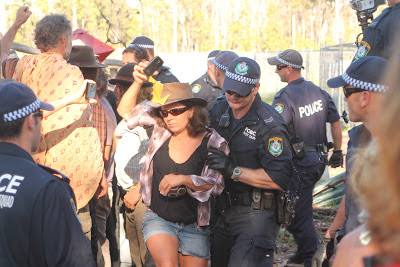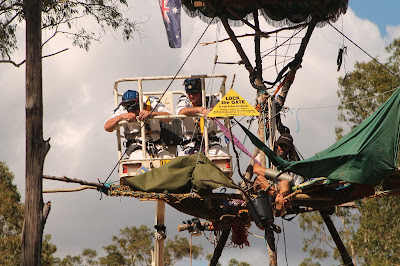Coal seam gas
mining company Metgasco finally moved its drilling rig and other equipment onto
the drill site at Glenugie on Monday 7th January.
Background to Events of 7th
January
Towards the
end of November last year Metgasco,
which had negotiated an agreement with the landholder, set up a drill pad on the property in the
Avenue, at Glenugie, south-west of Grafton.
Local residents, concerned at the company's failure to provide them with
information about their plans and concerned for the local environment,
established a vigil outside the site.
This vigil
became a blockade on 4th December when the company sent fencing
equipment to the site. Access to the
site was blocked by protesters and local resident Deb Whitley locked herself
onto one of the trucks. Eventually the
Police Rescue Squad arrived and freed Ms Whitley. Then local police and members of the Riot
Squad cleared access so that the vehicles were able to enter the site. Two concentric internal fences were set up
around the drill pad over the next few days.
Company
trucks made a further attempt to access the site on 10th December
but were held up by protesters as they attempted to reach the site. As there were only a few local police
present, the Metgasco workers gave up and returned to Casino.
The vigil
continued with anti-CSG campaigners expecting the imminent arrival of the drill
rig and other equipment. The weeks' long wait enabled the protesters to strengthen defences and also to broaden
understanding of CSG as an issue in the local community. The protest encampment along the road
expanded. Supporters from further afield
visited the site, many of them staying for days and returning a number of
times.
Drill Rig Day – 7th January
Following notification that the Metgasco convoy had left Casino, protesters camping near the drill site started strengthening the blockade. They were soon joined by locals from Grafton and and surrounding communities while others travelling from further afield arrived later.
Around 60 police - local officers, Riot Police from Sydney and members of the Police Rescue Squad - were at the site very early. The Riot Police blocked off the area in front of the access gate and, in a line, started pushing forward towards the road to move some 30 or 40 protesters from this area . When this was done, they started clearing protesters from the road in front of the gate.
 |
| Riot police moving protesters from in front of the property gate |
 | |||
| Protesters sitting on the road before Riot Police start pushing them back |
Once the protesters had been shifted from the area close to the gate, the Police Rescue Squad moved in to remove the protester locked on at the top of the tripod near the gate. This took some time as did the freeing of the man locked on just outside the gate. At the same time, police were demolishing or shifting the barriers to vehicle access including a large log placed parallel to the road.
 |
| Police Rescue Squad officers on a cherrypicker prepare to cut free a protester locked on to a tripod |
 |
| Filming the crowd |
The police then announced that they were closing off the road and, some time later, stationed police cars at the beginning of the Avenue to the south and at the junction of the Avenue and Six Mile Lane.
While the activity around the site was taking place, the drill rig and a number of other trucks approached the site along the Avenue from Ulmarra to the north. These vehicles pulled up three to four kilometres from the site to wait for the police to clear the road of protesters. While they were parked, a woman locked herself on to one of the trucks. So, when the Police Rescue Squad had finished its work near the drill site, they drove to these vehicles and released the locked-on woman. A further delay occurred when another woman locked herself onto a car parked partially on the road near Six Mile Lane.
After this woman was released and arrested, the drill rig and accompanying trucks moved to the drill site, arriving there at around 3 p.m.
While it was a peaceful protest, there were a number of incidents. Eighteen protesters, including the "lock-ons", were arrested. It was interesting that one of these, a prominent Northern Rivers ant-CSG campaigner, was arrested because he threw a bottle of water to one of the locked-on protesters near the drill site.
There were reports of excessive force being used by police and these incidents are likely to be pursued by the anti-CSG campaigners.
Six of those arrested appeared in Grafton Court the next day. The other 12 had been released on bail the evening before after being charged. Those who remained in custody overnight did so because they refused to accept one of the bail conditions imposed - namely that they stay at least 3 kilometres away from the drill site until their charges were decided on in court. This effectively meant that they were being denied the opportunity to protest peacefully outside the site for more than a month. The magistrate accepted their contention that this was not fair. In four cases he removed the restriction completely but warned those charged that they would need to be of good behaviour and not breach their bail in the period before the hearing on 11th February. The other two only sought the right to return to collect property left in the vicinity of the protest. They were granted two hours after their release to do this.
It will be interesting to learn just how much the police operation around the 7th January has cost the public purse - assuming the State Government informs the community of this cost. The Government will certainly be asked the question.
While the activity around the site was taking place, the drill rig and a number of other trucks approached the site along the Avenue from Ulmarra to the north. These vehicles pulled up three to four kilometres from the site to wait for the police to clear the road of protesters. While they were parked, a woman locked herself on to one of the trucks. So, when the Police Rescue Squad had finished its work near the drill site, they drove to these vehicles and released the locked-on woman. A further delay occurred when another woman locked herself onto a car parked partially on the road near Six Mile Lane.
After this woman was released and arrested, the drill rig and accompanying trucks moved to the drill site, arriving there at around 3 p.m.
 |
| The drill rig, protected by Riot Squad police, moves past Six Mile Lane to the drill site. |
There were reports of excessive force being used by police and these incidents are likely to be pursued by the anti-CSG campaigners.
Six of those arrested appeared in Grafton Court the next day. The other 12 had been released on bail the evening before after being charged. Those who remained in custody overnight did so because they refused to accept one of the bail conditions imposed - namely that they stay at least 3 kilometres away from the drill site until their charges were decided on in court. This effectively meant that they were being denied the opportunity to protest peacefully outside the site for more than a month. The magistrate accepted their contention that this was not fair. In four cases he removed the restriction completely but warned those charged that they would need to be of good behaviour and not breach their bail in the period before the hearing on 11th February. The other two only sought the right to return to collect property left in the vicinity of the protest. They were granted two hours after their release to do this.
It will be interesting to learn just how much the police operation around the 7th January has cost the public purse - assuming the State Government informs the community of this cost. The Government will certainly be asked the question.
